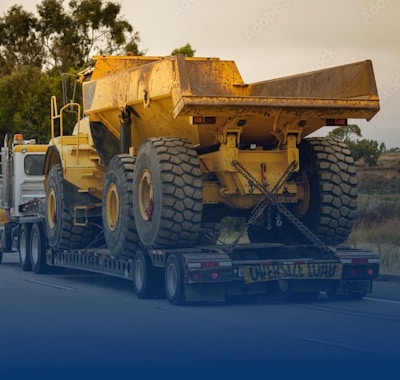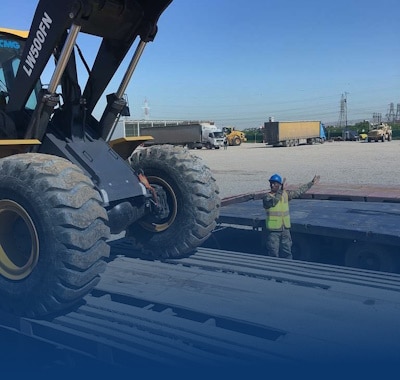Managing Heavy Haul Logistics in Midwest Farm Country
Freedom Heavy Haul can offer expedited Pickup and Delivery for any size shipment anywhere in the USA. Contact us today for No Hassle, No Pressure Pricing.
Seasonal harvest cycles reshape how transportation works in rural areas. Field traffic, tight windows, and shifting driver availability tighten the market fast. This guide shows practical steps to keep equipment moves on time and safe.
Good planning makes a difference. You will learn timing cues, compliance checkpoints, route strategies, and realistic cost expectations. The focus is on moving combines, tractors, and trailers with minimal disruption to active operations.
Equipment readiness and road access matter more in this season than in normal logistics. Narrow lanes, soft shoulders, and short loading windows add real challenges. Coordination with crews and a responsive partner cuts risk and keeps utilization high.
Budgeting for peak demand helps avoid surprise costs. A repeatable framework helps teams adapt faster each year and maintain performance across the region. Expect clear checklists, route tips, and cost controls ahead.
Why harvest season reshapes heavy haul logistics in the Midwest
When fields fill with activity each fall, regional freight patterns shift fast. Mid-September to around Thanksgiving is the core window in Illinois, Indiana, Iowa, Kansas, Minnesota, Missouri, and Nebraska.
Driver and capacity shifts tighten lanes as many drivers leave long-haul runs for local support. Dry van and reefer space shrinks, and that ripple affects non-agriculture shippers too.
Weather adds uncertainty. Warm or wet stretches can push start and end dates, forcing teams to change plans on short notice.
- Compressed lead times: Farms prioritize moving equipment and crops, so pickups must be faster.
- Operations flex: Rural access, staging areas, and narrow roads require different routing and timing.
- State-level nuance: Each of the core states shows different driver participation and policy impacts.
Clear, friendly communication with crews and drivers eases these challenges and keeps schedules intact when equipment moves collide with peak field activity.
Timing and terrain: When and where harvest season hits hardest
Peak field activity compresses pickup windows and changes how teams plan moves. The core timing runs from mid‑September through around Thanksgiving, and that window can shift based on weather from one year to the next.
Calendar window
Expect the most pressure between mid‑September and Thanksgiving. Track local reports so you can adapt when timing harvest slides with rain or warm spells.
Core states
Illinois, Indiana, Iowa, Kansas, Minnesota, Missouri, and Nebraska drive the largest demand. These states move bulk crops like corn, soybeans, wheat, and cereal grains, which keeps elevators and routes busy.
Spillover states and crops
The Dakotas, Ohio, Michigan, and Wisconsin add specialty produce—canola, cranberries, pumpkins, and sunflowers—that creates extra handling needs even if overall pressure is lower.
- Rural routes shift from highways to narrow roads where size and access restrictions matter.
- Map priority corridors early to spot tight turns and low clearances.
- Align machinery moves with crop flow to cut empty miles.
| Region | Primary Crops | Logistics Notes |
|---|---|---|
| Core grain belt | Corn, soybeans, wheat | High, sustained demand; staging near elevators |
| Spillover states | Canola, cranberries, pumpkins | Special handling; variable peak timing |
| Routes | Highway to county roads | Plan for tight turns, low clearance, time‑of‑day limits |
Managing heavy haul across Midwest farm country during harvest
Local demand pulls professional drivers off long runs and into nearby equipment moves. This shift reduces long‑haul capacity quickly and changes how teams plan pickups.
How driver behavior shifts capacity: OTR to local farm work
Many drivers pause OTR schedules to earn similar pay working near home. That swap cuts the pool of available drivers for time‑sensitive shipments.
Trailer implications: dry van, reefer, and open‑deck impact
Dry van and reefer supply tightens fastest because produce needs and transferable skills pull drivers to local loads. Open‑deck trailer options are less affected but can still be scarce when machinery moves spike.
What this means for timing, delays, and pickup windows
Plan earlier and build flexibility. Book sooner, expand pickup windows, and accept flexible delivery windows to absorb common delays.
- Confirm exact pickup points and field contacts to reduce failed attempts.
- Bundle shipments where possible to cut empty miles and improve driver acceptance.
- Check in with carriers about driver availability so you can prioritize critical loads.
- Document machinery needs—securement, clearance, and special instructions—before tendering loads.
“Clear staging notes and a quick confirmation call often turn a tight capacity day into a successful pickup.”
| Issue | Impact | Practical step |
|---|---|---|
| Drivers shift locally | Fewer OTR options for time‑sensitive shipments | Book earlier; increase lead time |
| Dry van / reefer tightness | Produce and transfer skills reduce availability | Prioritize and confirm reefer needs; consider alternatives |
| Open‑deck variability | Less affected overall but scarce in peak machinery moves | Coordinate machinery readiness and staging windows |
| Rural delays | Higher chance of failed pickups and longer dwell | Provide exact yard contacts and staging maps |
Compliance, weight, and route requirements to keep loads moving
Knowing rules up front keeps loads moving and avoids costly delays on rural roads. Requirements vary by state and by route type, so plan for non-interstate limits and local postings before you call a driver.
Know the rules: state-by-state variances and non-interstate limitations
State proclamations and county notices change allowable size and weight quickly. Treat each move as a unique compliance task. Confirm which routes can carry your equipment and whether permits are needed.
Iowa example (present): seasonal allowance up to 90,000 lbs
On Oct. 9, 2024 Iowa issued a harvest proclamation allowing vehicles carrying corn, hay, silage, soybeans, stover, straw, and certain fertilizers to operate up to 90,000 pounds gross on non‑interstate highways through Nov. 8 without a permit. This example shows how a season proclamation can raise gross limits while leaving local rules in place.
Axle limits and posted bridges
Axle limits still apply: the legal axle cap is 20,000 lb. The proclamation requires loads not exceed the non‑primary highway table by more than 12.5%. Always check bridge postings and county road restrictions first.
Bridge postings, county roads, and detour planning
Document proclamations, axle calculations, and approved routes in each load file. Confirm routes with dispatch and plan contingency routes and appointment buffers in case postings change or weather makes a road unsafe.
- Verify local requirements and which routes allow increased weights.
- Check axle spacing and securement plans to meet size and axle rules.
- Confirm bridge postings, county limits, and field access ahead of time.
- Keep route approvals and proclamations with the load paperwork for driver reference.
“Compliance diligence speeds approvals, reduces re‑routing, and keeps loads on schedule.”
| Focus | Practical note | Legal limit |
|---|---|---|
| State variances | Confirm local proclamations and permit exceptions | Varies by state |
| Iowa example | Up to 90,000 lb gross on non‑interstates Oct. 9–Nov. 8, 2024 | No permit required ≤90,000 lb; axle cap 20,000 lb |
| Axle & size | Plan spacing, securement, and calculated axle loads | Max axle 20,000 lb; 12.5% rule vs. non‑primary table |
| Routes & bridges | Verify postings; plan detours and backup corridors | Bridge postings and county limits control access |
Plan early, stage smart: capacity, timing, and field operations
A summer scheduling chat can save hours on the loading dock and keep tractors rolling on time. Start by sharing likely needs and trailer types so carriers can plan crews and assets before the busiest weeks arrive.
Lead times that work
Early notice lets partners reserve capacity and prioritize critical moves. Send summer forecasts, expected pickup windows, and equipment lists so teams can balance lanes ahead of the rush.
Flexible pickup and delivery windows
Build flexible timing into appointments. Wider windows help capture scarce capacity and reduce failed attempts. Give carriers clear contact points and alternate staging spots to ease rural access.
Field-access readiness
Confirm staging areas, surface conditions, approach angles, and turning radius for combine moves. Coordinate when combines and grain carts will clear approaches so trucks can load and depart without delay.
- Share load specs early: dimensions, weight, and securement needs.
- Prioritize critical equipment and pair nearby pickups to cut empty moves.
- Build a little extra buffer for gate delays and moisture checks.
“A short prep call beats a full day of rework on site.”
Weather patterns and routing strategies you can trust
When weather shifts fast, a simple plan keeps loads safe and schedules intact. Monitor forecasts for origin, destination, and key routes every day. Build small time buffers so a sudden storm or early snow doesn’t force a failed pickup.
Monitor volatile Midwest weather and build time buffers
Track local radar and highway notices before dispatch. Use dynamic ETAs and proactive alerts so facilities and crews know when delays are likely.
Alternate routes and service-area pivots to avoid storm-related shutdowns
Identify two safe alternative routes for each move and map staging spots that handle large equipment if rain or hail closes primary roads. Schedule critical loads earlier in the week or day when windows are usually clearer.
- Check weather patterns daily and add time buffers for surprise slowdowns.
- Keep regional communication tight—drivers, dispatch, and site contacts.
- Document safe havens for quick staging when conditions turn bad.
- Update playbooks each year with lessons from the current season.
“Quick reroutes and calm, clear calls keep operations moving when weather threatens planned appointments.”
Costs, rates, and budget levers during harvest season
Expect seasonal price shifts as local demand pulls drivers into short runs and tightens capacity. Spot market rates rise where dry van and reefer availability drops. That trend raises the overall cost and forces teams to balance price with service.
Practical levers include modest rate flexibility, multi-stop routing, and aligning backhauls to cut empty miles. Publish target rate ranges early so partners can commit capacity for critical shipments.
Expect spot market increases: supply and demand realities
Set clear expectations that costs rise when capacity tightens. Weather and short‑notice coverage can push price even higher, so build buffers and watch timing closely.
Cost-effective tactics: rate flexibility, multi-stop optimization, backhaul alignment
- Be flexible on rate in small increments to secure reliable crews without overpaying.
- Combine nearby loads and confirm exact size and securement to avoid last-minute equipment swaps that add cost.
- Use paired moves—machinery repositioning with crop freight—to stabilize rates over the year.
“Small timing concessions and a little extra pickup window often attract drivers at a predictable price.”
| Focus | Practical step | Benefit |
|---|---|---|
| Published ranges | Share target rates early | Better capacity commitments for shipments |
| Right-sizing | Confirm size, weight, securement | Fewer last-minute changes and lower unexpected costs |
| Season data | Use past year corn & soybeans corridors | Refined budgets and fewer surprise spikes |
Work the market with the right partner and processes
Finding the right carrier and clear processes makes tight pickup windows manageable. Choose a partner with proven experience who can explain coverage plans and lead‑time needs quickly.
What to ask your provider
Experience: How many seasons of equipment moves have they handled? Ask for references from other farmers.
Coverage plans and lead time: Which regions do they staff, and what notice do they need to secure drivers when capacity tightens?
Why responsiveness matters
Fast replies save hours. Freedom Heavy Haul customers say the team “always get back to us immediately,” offers “the best price possible,” and gives professional service.
“They get back to us immediately and deliver fast quotes that let us decide in minutes.”
- Set SLAs: response time, escalation paths, after‑hours contact.
- Align on price expectations and transparent costs.
- Confirm knowledge of equipment specs, yard access, and on‑site instructions.
- Value partners that propose creative load pairing and routing to beat the market.
| What to check | Why it matters | Quick question to ask |
|---|---|---|
| Seasonal experience | Reduces first‑attempt failures | How many similar moves this season? |
| Response SLA | Saves time when windows open | What is your callback time? |
| Coverage & drivers | Secures crews in tight conditions | How do you source backup drivers? |
Example: Customers like Tim Allen, John Armstrong, and Elizabeth Martin praise fast quotes and dependable execution, proving that personal attention changes outcomes for time‑sensitive shipments.
Your harvest playbook for dependable heavy haul, this season and next
A short checklist can turn seasonal pressure into predictable, cost‑effective moves.
Plan early: confirm forecasts, list equipment and size, and lock critical coverage so shipment windows stay realistic. Build time buffers and flexible pickup windows to absorb common delays.
Budget with discipline: forecast costs and set target rate ranges. Pre‑approve modest rate flexibility for peak weeks to keep loads moving.
Protect capacity: stage equipment, right‑size assets to match requirements, and sequence loads to cut empty miles on machinery moves. Note lane nuances—corn and soybeans corridors often face the steepest delays and driver competition in key states.
Record lessons each year, add daily weather checks with alternate routes, and align with a responsive partner whose experience keeps transportation operations smooth. Confirm forecasts, lock coverage, pre‑approve flexible rates, and standardize communications so every shipment stays on track this harvest season and next.







